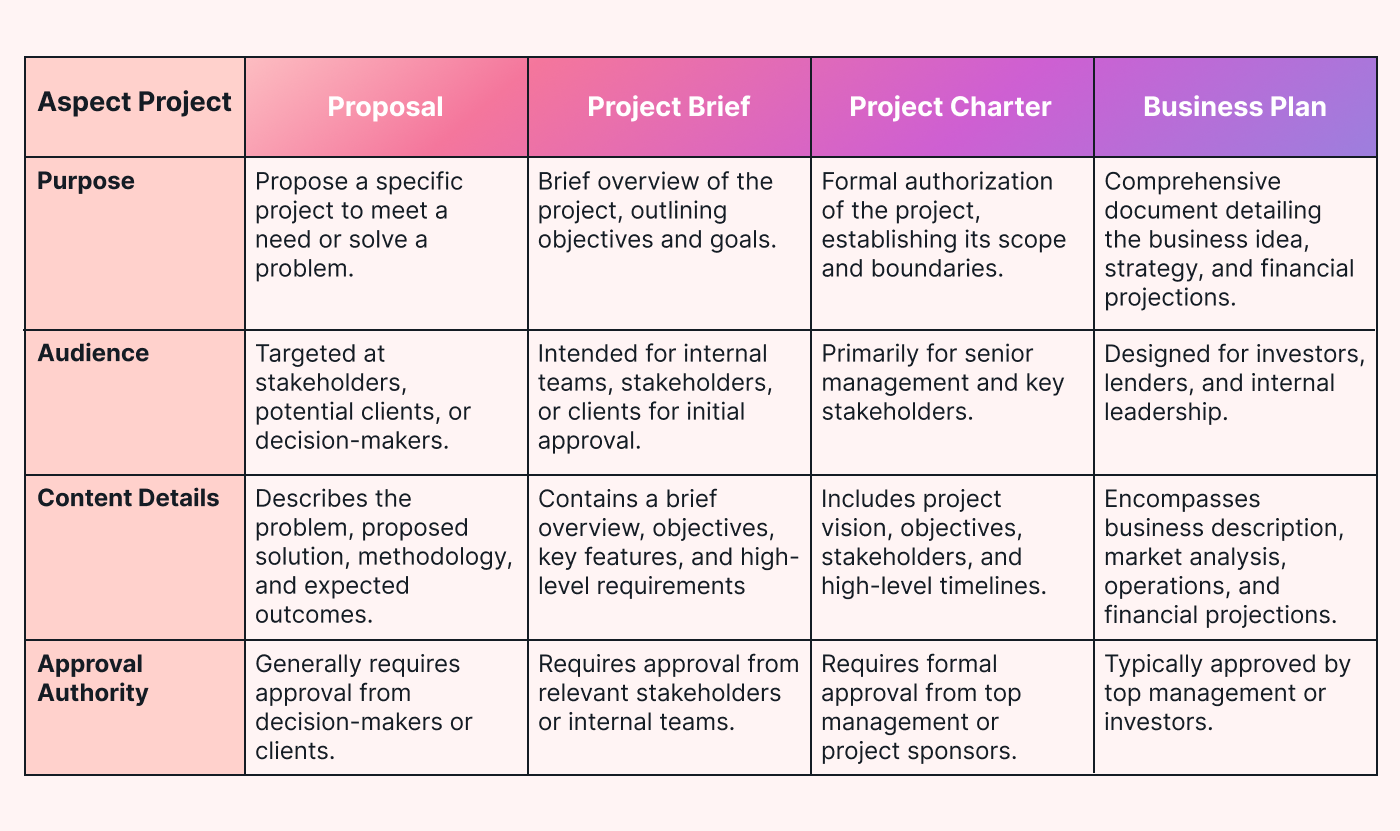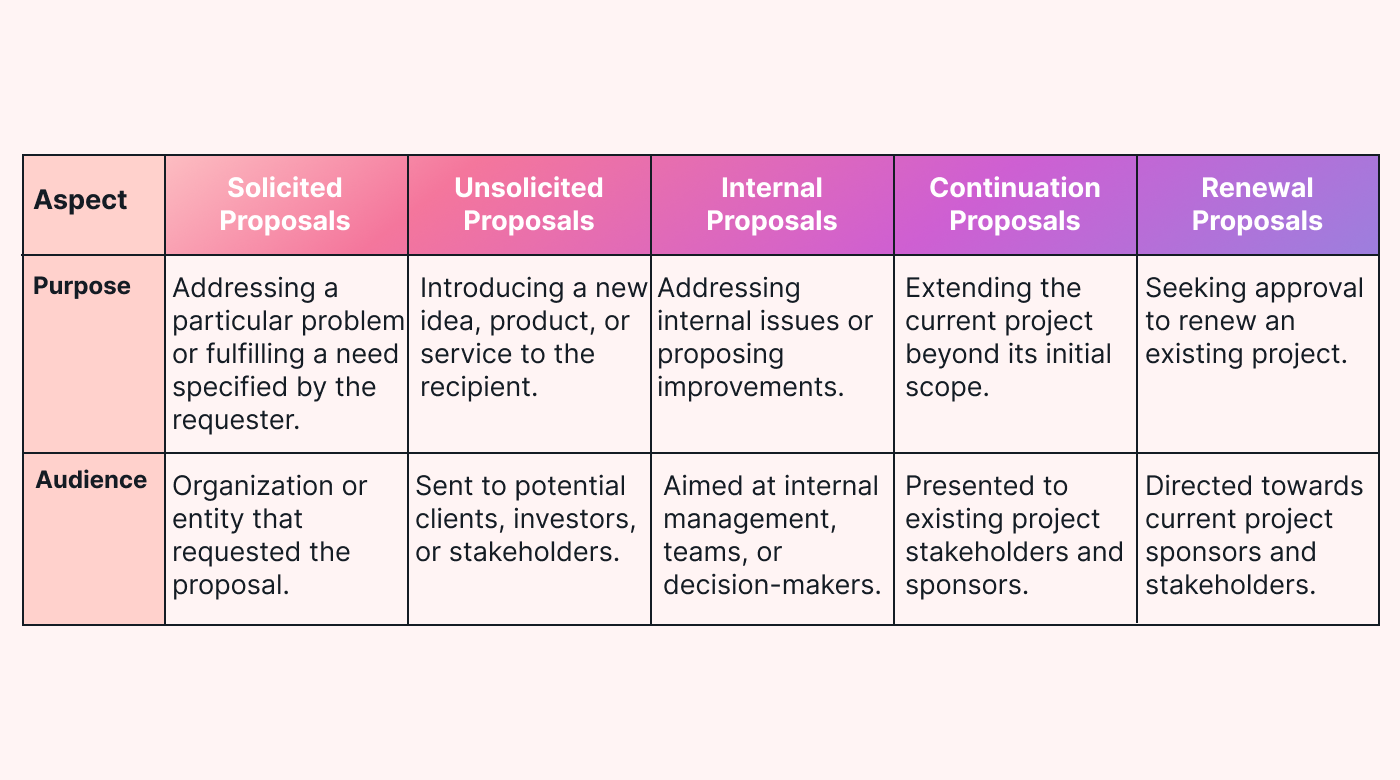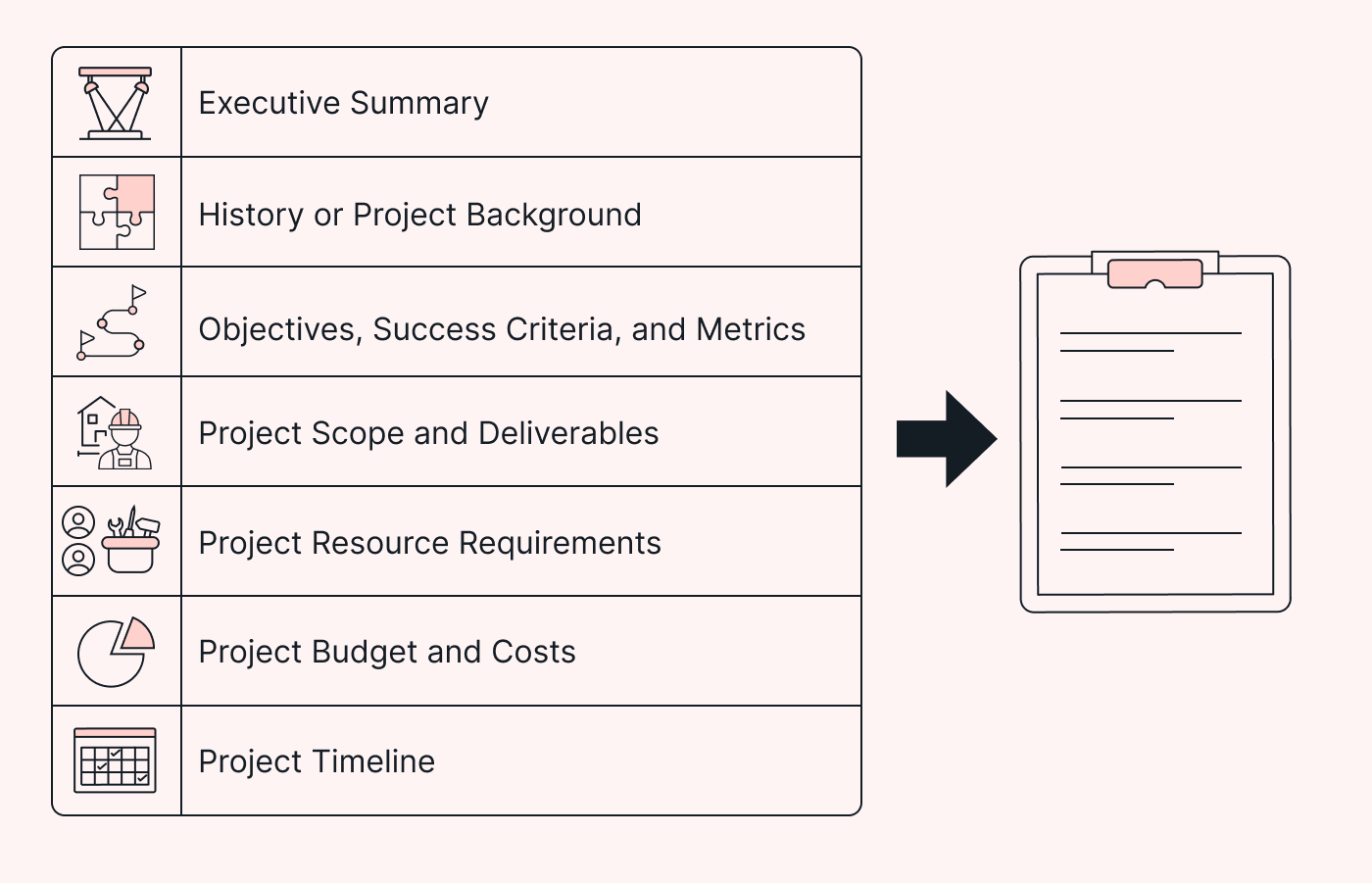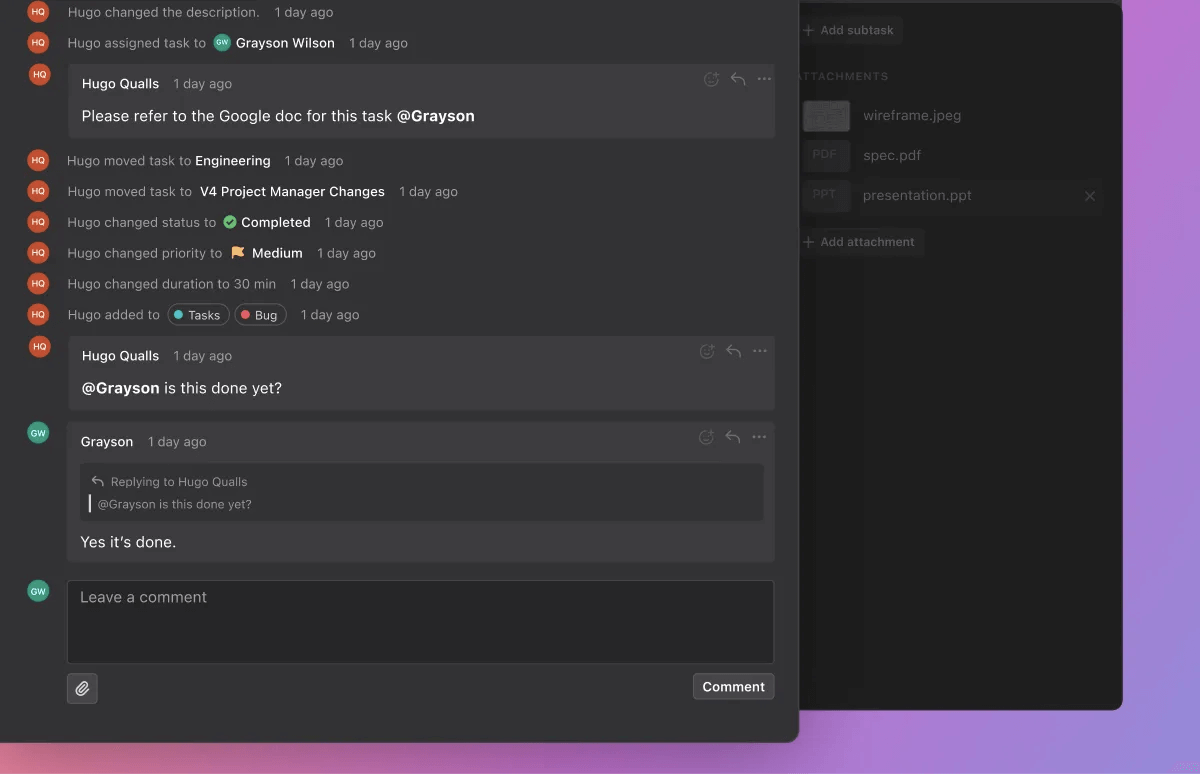Do you have a concept for a project that you are passionate about? Can you picture how it'd be implemented? What advantages will it bring to your team or business?
A project proposal is a way to communicate that vision to others.
Unless your project is a personal goal or small, you'll require support and cooperation from others for a successful project. A proposal is your first step towards getting that support from your team, company, or clients.
This article is your project proposal guide. It's filled with writing tips, tricks, and a step-by-step guide on how to draft a winning proposal.
What is a project proposal?
A project proposal is a formal document that outlines a project before it even gets to the planning phase, with the intent of describing what you are proposing and how it'll benefit the organization. Think of it like a business proposal.
A well-written project proposal includes specifics about key objectives, project lifecycle, project costs, project success criteria, and the needed resource allocations.
It's important to note that this document is the first time your project is introduced to key decision-makers, who'll decide whether they want to go down the path of your project idea.
A successful project proposal should excite decision-makers about your project so that you get approval and the resources to do it.
Project proposal vs. project brief vs. project charter vs. business plan
At first look, these documents may appear to be similar. They all explain your project, the scope of work, and the results.
 |
However, there are some key differences, such as whom they're for, what they do, and how detailed they are.
A project proposal lays out the business case, if you will, of a project and is intended to get buy-in.
A project brief describes the project team's objectives, scope, and requirements.
A project charter is more detailed than a brief and a proposal. It sets out your project scope, goals, and how you plan to achieve them.
A business plan is a document that describes how the business plans to achieve its goals and objectives in (as comprehensive as possible) detail. A business plan can also have a lot of details, like the business's mission, market analysis, marketing strategies, financial projections, and long-term goals. It's intended for a larger audience, including potential investors, lenders, partners, and internal stakeholders.
Types of project proposals
There are different situations where you might need to write a project proposal, where each type of project proposal has a slightly different intent and approach. Below is a summary of five common types.
 |
Let's dive into the different types of proposals a bit deeper.
Solicited proposals
A solicited proposal is an answer to a request for proposal (RFP) or other formal solicitation for services. These typically come from existing or new customers, organizations, or government agencies.
Not much guesswork in these. Solicited proposals specify what should be included in the proposal.
Unsolicited proposals
Unlike solicited proposals, a customer or company doesn't ask for unsolicited project proposals. This type of proposal, instead, tries to excite a potential client (or stakeholder) about an idea.
Speaking of ideas, these might be spontaneous ideas like solutions to sticky problems you've figured out. Or they might (just) be for more resources to solve those sticky problems.
Internal proposals
Internal project proposals help individuals or groups within a company get approval for a new venture or project.
In-house projects often aim to improve internal procedures or systems. To get approval, with these types of proposals, you'll want to show how your project will benefit the organization.
Continuation proposals
Continuation project proposals are documents designed to extend an ongoing project or agreement.
Continuation proposals are used when a project is complete or near completion and you, the client, or stakeholder(s) want to continue working together.
These proposals summarize the completed tasks to date and the tasks that still need to be tackled. They include a schedule, budget, and any potential changes to the original project scope.
Renewal project proposals
Renewal project proposals help you restart or continue a previous project that's ended.
Crafting a renewal project proposal can be difficult, especially when the reasons for termination are less than ideal. In such a case, you must showcase the project's value proposition by detailing out the goals, benefits, and potential ROI.
Write a project proposal in 6 steps with examples
Now that you know the types of proposals, let’s dive into writing one.
Here’s an effective project proposal outline for you to steal:
 |
No matter what type of proposal you have, it should include:
- An executive summary of the project.
- History or project background the proposal is looking to resolve (or the potential advantage that it provides).
- Objectives, success criteria, and metrics for the proposed project.
- Project scope and deliverables should highlight what’s part of the project and the items you’ll present to the client or stakeholders.
- Project resource requirements include people, materials, and tools needed for the project to succeed.
- Project budget and costs of all the project activities.
- Project timeline for the project along with the milestones.
Other information that you can include:
- Potential risks and mitigation strategies.
- Project approach or project methodology.
- Expected benefits of the project.
- Other details that might be important to note.
1. Capture your executive summary and background
Start your proposal with an executive summary (sometimes called an elevator pitch). Try to capture all the essential information about the project in a concise summary that paints a picture of the whole project.
Executive summary example: SmartGreens wants to change how people garden using technology. Our project centers around using smart sensors, automatic watering systems, and intuitive apps to help water and track how a garden grows. It removes the need to guess about soil moisture or worry about watering times.
For background, you'll want to explain:
- Why are you proposing this project? Is it a response to an issue? How did you discover that there is a requirement or enthusiasm?
- The aim of this section is to clarify why the project is vital
Background example: Gung-ho gardening often involves trying to figure out the perfect soil moisture level and watering times, which is a pain for many gardening enthusiasts. Based on market research, we believe that our solution is in high demand and will bring in thousands of customers.
2. Write your objectives, success criteria, and metrics
Next, you’ll need to write the project objectives. It’s best if these are SMART goals (smart, measurable, achievable, realistic, and time-bound).
Objectives example:
- Create the SmartGreens app within the first three months.
- Introduce an automated watering system that can reduce water consumption by 25% within the first six months.
- Capture 50,000 customers within the first fifteen months.
You’ll also need to detail the success criteria so that you have a way to verify that the project is achieving its intended purpose.
Success criteria example:
- Complete the SmartGreens app.
- Implement the automated watering system.
- Achieve the customer acquisition goal.
It's important to establish a system to measure and evaluate these metrics and take action if they aren't in line with your purpose. (Tip: project management software is good for this.)
3. Scope and deliverables
The project scope covers all the work, outputs, and components to be carried out and spells out the deliverables of the project.
What exactly is included in your project? What are the artifacts that will come from the project? What deliverables will you create and deliver?
For a proposal, you probably won't go into the details of tasks, but you'll still want to give a high-level description of them.
This is also the place to include potential constraints and issues you'll need to work around and any exclusions the project won't cover.
Scope example: Create a mobile app with plant monitoring and watering features.
Deliverables:
- Smart sensor integration.
- User-friendly interface.
- App with various features.
Scope constraints:
- The budget.
- The timeline.
4. Project resource requirements
The whole mission of the proposal is to get approval for the resources you need to turn your idea into tangible results. You'll need to add what resources you require and how you'll use them.
Resource requirements example:
Resources
- Project manager: 1
- App developers: 4 (2 for iOS, 2 for Android)
- System engineers: 2
- Marketing team: 3
- Community manager: 1
Software
- Development tools (Xcode, Android Studio)
- Design software for UI/UX development
- Coding languages (Swift, Kotlin/Java).
Hardware
- Computers for app developers and engineers.
- Testing devices for iOS and Android.
Smart sensors and watering system
- Smart sensors for soil moisture and plant health monitoring.
- Automated watering system components (valves, pumps, controllers).
Marketing campaign
- Allocate $130,000 for online and offline marketing campaigns.
You'll have to decide how to manage the resources later. This is a part of creating a project plan, and you'll use the proposal and initial estimates to do so.
5. Estimate project budget and costs
There are no free lunches. All work comes with costs.
It's essential to calculate expenses and create a project budget as soon as possible. You can always start with a rough order of magnitude (ROM) estimate, and then get more detailed as the project matures.
Project budget and cost example:
Human resources cost
- Project manager: $80,000
- App developers (4): $240,000
- System engineers (2): $140,000
- Marketing team (3): $150,000
- Community manager: $60,000
Software and hardware costs
- Development tools and software licenses: $30,000
- Testing devices and equipment: $20,000
- Total Technology Resources Cost: $50,000
Smart sensors and watering system
- Smart sensors and components: $40,000
Marketing campaign Budget:
- Online and offline marketing campaigns: $100,000
- Promotional offers and incentives: $30,000
Total budget: $940,000
For a ROM estimate, your budget will be $705,000 to $1,645,000.
6. Timeline
This is where the rubber meets the road.
Once you know the scope of your project, you should plan a broad amount of time each deliverable will take to form a rough project schedule.
Timeline example:
- Planning phase (Month 1)
- App development (Months 2-4)
- Automated watering system implementation (Months 2-6)
- Marketing and customer acquisition (Months 5-15)
- Continuous improvement (Months 5-15)
- Final evaluation and reporting (Month 15)
(Another tip: you can always add other elements to your project proposal templates, like potential risks and mitigation strategies, project approach, and expected benefits.)
3 tips for better project proposals
Now that you have a project proposal format, here are some tips to make the process easier and more effective.
Collaborate
Your team probably knows a thing or two about the work that you don't. Tap into that.
For example, they might see a way to reach a deliverable in a way that can help you win approval.
Also, get others to review your proposal. A fresh set of eyes will always help.
Keep it simple
A project proposal shouldn't be complicated. Don't be verbose, avoid jargon, and ensure everything is plain and comprehensible.
The people reading the proposal aren't looking for a thesis (and probably don't have the time). Keep it concise.
Centralize your communication and documentation
Project management software can help you communicate with your team, stakeholders, and clients. That's a big deal in a world where the early bird gets the worm.
A project management app can also help you to keep your files and communication in one place.
Should your proposal get approved, you can use the project management app to create the project timeline and schedules.
 |
Plan and put your proposals into action with Motion
Great, your project proposal was approved! Now let Motion help you put it into action.
Motion's AI will help create the ideal project schedule and help you stay on top of project tasks.
If (or when) changes occur, it can redistribute task allocations automatically and help you reach your goals on time.
Sign up for your 7-day free trial.

Hailing from South Africa, Richard Reynolds is a seasoned project & product management writer at large (last sighted in Vietnam!) With 5+ years experience in the field, a BA in Psychology, and education in Biz Mgmt & Professional Project Management, Richard remains passionate about simplifying complex project concepts with seasoned professionals and newbies alike.




